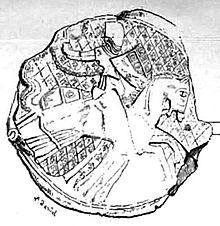
Back روبرت امير تارانتو ARZ Роберт Тарэнцкі Byelorussian Robert II de Tàrent Catalan Robert von Tarent German Ροβέρτος του Τάραντα Greek Roberto de Tarento Spanish روبر، شاهزاده تارانتو Persian Robert de Tarente French Roberto de Tarento Galician Robert, knez Taranta Croatian
| Robert II | |
|---|---|
| King of Albania Prince of Taranto Prince of Achaea titular Latin Emperor | |
 Seal of Robert of Taranto | |
| King of Albania | |
| Reign | 1331-1332 |
| Predecessor | Philip I, Prince of Taranto |
| Successor | John, Duke of Durazzo (as Duke of Durazzo) |
| Born | 1319/1326 |
| Died | 10 September 1364 |
| Spouse | Marie de Bourbon, Princess of Achaea |
| House | House of Anjou-Sicily |
| Father | Philip II, Latin Emperor |
| Mother | Catherine II, Latin Empress |

Robert II of Taranto (1319 or early winter 1326 – 10 September 1364[1]), of the Angevin family, Prince of Taranto (1331–1346), King of Albania (1331–1332), Prince of Achaea (1332–1346), and titular Latin Emperor (1343 or 1346 – 1364).
He was the oldest surviving son of Prince Philip I of Taranto (1278–1331) and Empress Catherine II of Valois.[1]
In 1332, an exchange occurred in which his uncle John of Gravina arranged to surrender Achaea to him in exchange for Robert's rights to the Kingdom of Albania and a loan of 5,000 ounces of gold raised upon Niccolo Acciaiuoli. Robert then officially became Prince of Achaea.[1] Because of his youth, authority was effectively exercised by his mother Catherine II of Valois until her death in 1346. At that point Robert inherited the throne of the Latin Empire, and was recognized as emperor by the Latin states of Greece. His actual power, such as it was, remained based upon his authority as prince of Achaea. In Naples, on 9 September 1347 , Robert married Marie of Bourbon, the daughter of Louis I, Duke of Bourbon Constable of Cyprus,[2] but the marriage was childless. He died on 10 September 1364 in Naples and was buried there.[3] After he died,[4] his widow attempted to keep the principality for herself and her son from her previous marriage. However, Robert's younger brother Philip II of Taranto succeeded as the legitimate heir.
- ^ a b c Lock 1988, p. 129.
- ^ Topping 1975, p. 132.
- ^ Topping 1975, p. 141.
- ^ Setton 1975, p. 673.